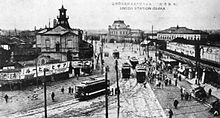Osaka tram
| Osaka urban tram | |
|---|---|
| Car 528, taken in 1993 | |
| Basic information | |
| Country | Japan |
| city | Osaka |
| opening | 1903 |
| Shutdown | 1969 |
| operator | Osaka Tourist Office |
| Infrastructure | |
| Formerly the largest route |
approx. 118 km |
| Gauge | 1435 mm ( standard gauge ) |
| Power system | 600 V = overhead line |
The Osaka tram , or Osaka Municipal Tram ( Japanese 大阪 市 電 , Ōsaka-shiden ) was the tram network of the city of Osaka on the island of Honshū in Japan .
It was opened from 1903 by the city traffic office ( 大阪 市 交通局 , Ōsaka-shi Kōtsū-kyoku ). After constant network expansion into the post-war period, operations were gradually discontinued until 1969.
As the first municipal transport company (and the second standard-gauge railway) in the country, the city opened its first 5 km line from Hanazono-bashi ( 花園 橋 ) on the outskirts of the city in 1903 on the occasion of the 5th state industrial exhibition (but only after its end) to the newly built port on Tenpōzan ( 天 保山 ); it formed the first expansion stage of the network.
With the second expansion stage, the network was expanded by an additional 11 km to north-south and east-west routes through the city center from 1908–1910. At the same time, the third expansion phase was tackled in 1909, after which in 1916 a further 43 km could be completed. As a result, the construction of individual lines as required without any superordinate planning programs began and individual private railway lines were taken over.
In 1932 the fourth and last large-scale expansion phase was completed and the network expanded by more than 25 km. The basic structure of the network with chessboard-like routes throughout the city center and some of the outer routes extending far into the suburbs was thus complete. It was supplemented in 1933 by the first line of the Osaka urban subway . The cars always had a characteristic red-brown paint job; A special feature of the company were the double-deck cars used in the early days.
In 1944, the city also acquired the separate route of the (old) Hankai-Dentetsu ( 阪 堺 電 鉄 ) from Ashihara-bashi ( 芦 原 橋 ) to Hamadera ( 浜 寺 ), with which the network got its largest extension with almost 118 km in length; it had to be shortened the following year due to war damage. Further war damage caused the network size to stagnate despite the renewed expansion of the line soon after the end of the war. So were z. B. in the area Tanimachi ( 谷 町 ) and Nakanoshima ( 中 之 島 ) routes only partially rebuilt. The expansion of the subway network, which was soon to revive, and the establishment of a trolleybus operation in 1953 ensured a constant decline from 1960 onwards, after the last new line to Midori-bashi ( 緑 橋 ) was not completed until 1957 . In addition, due to the new transport policy, a city council resolution was issued in 1966 to shut down trams until 1968.
After consistently abandoning almost all routes, only those to Moriguchi ( 守 口 ) and Imazato – Tamaebashi ( 今 里 〜 玉 船 橋 ) remained until the beginning of 1969 . Although the process was delayed by several months, operations now inevitably ceased - on March 31, 1969, the last car moved in. The trolleybus service, which had meanwhile covered more than 38 km, was also discontinued on June 15, 1970.
In addition to the now eight underground lines, buses and individual railway extensions took over the transport services. After that, only individual tram lines operated by private companies outside the city center remained. The resumption of inner-city operations that has been contemplated has not yet got beyond the stage of discussion.
The tourist office has a museum with original trams without regular opening times (events).
Web links
Remarks
- ↑ The oldest is the Keikyū Daishi line in Kawasaki




